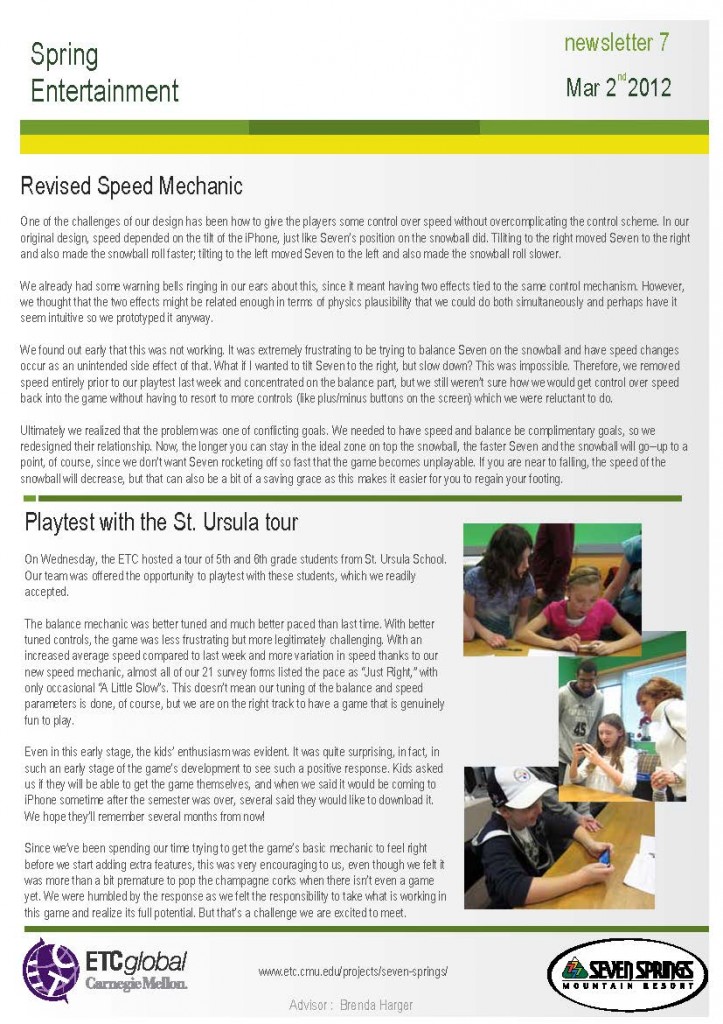Newsletter #7
Revised Speed Mechanic
One of the challenges of our design has been how to give the players some control over speed without overcomplicating the control scheme. In our original design, speed depended on the tilt of the iPhone, just like Seven’s position on the snowball did. Tilting to the right moved Seven to the right and also made the snowball roll faster; tilting to the left moved Seven to the left and also made the snowball roll slower.
We already had some warning bells ringing in our ears about this, since it meant having two effects tied to the same control mechanism. However, we thought that the two effects might be related enough in terms of physics plausibility that we could do both simultaneously and perhaps have it seem intuitive so we prototyped it anyway.
We found out early that this was not working. It was extremely frustrating to be trying to balance Seven on the snowball and have speed changes occur as an unintended side effect of that. What if I wanted to tilt Seven to the right, but slow down? This was impossible. Therefore, we removed speed entirely prior to our playtest last week and concentrated on the balance part, but we still weren’t sure how we would get control over speed back into the game without having to resort to more controls (like plus/minus buttons on the screen) which we were reluctant to do.
Ultimately we realized that the problem was one of conflicting goals. We needed to have speed and balance be complimentary goals, so we redesigned their relationship. Now, the longer you can stay in the ideal zone on top the snowball, the faster Seven and the snowball will go–up to a point, of course, since we don’t want Seven rocketing off so fast that the game becomes unplayable. If you are near to falling, the speed of the snowball will decrease, but that can also be a bit of a saving grace as this makes it easier for you to regain your footing.
Playtest with the St. Ursula tour
On Wednesday, the ETC hosted a tour of 5th and 6th grade students from St. Ursula School. Our team was offered the opportunity to playtest with these students, which we readily accepted.
The balance mechanic was better tuned and much better paced than last time. With better tuned controls, the game was less frustrating but more legitimately challenging. With an increased average speed compared to last week and more variation in speed thanks to our new speed mechanic, almost all of our 21 survey forms listed the pace as “Just Right,” with only occasional “A Little Slow”s. This doesn’t mean our tuning of the balance and speed parameters is done, of course, but we are on the right track to have a game that is genuinely fun to play.
Even in this early stage, the kids’ enthusiasm was evident. It was quite surprising, in fact, in such an early stage of the game’s development to see such a positive response. Kids asked us if they will be able to get the game themselves, and when we said it would be coming to iPhone sometime after the semester was over, several said they would like to download it. We hope they’ll remember several months from now!
Since we’ve been spending our time trying to get the game’s basic mechanic to feel right before we start adding extra features, this was very encouraging to us, even though we felt it was more than a bit premature to pop the champagne corks when there isn’t even a game yet. We were humbled by the response as we felt the responsibility to take what is working in this game and realize its full potential. But that’s a challenge we are excited to meet.

